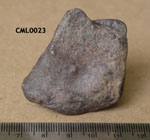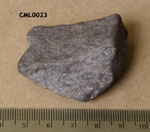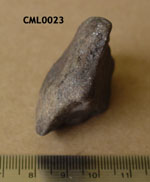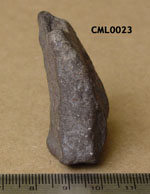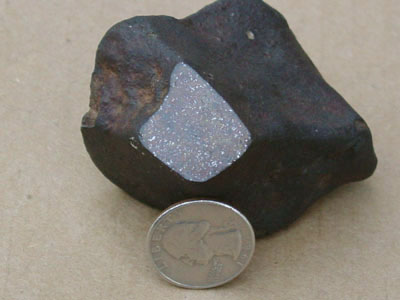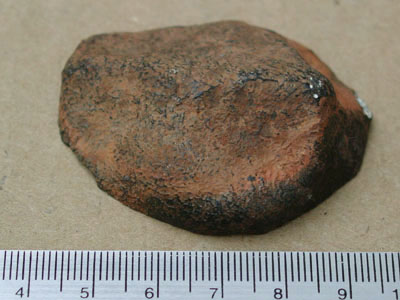
Meteorite identification
Properties of meteorites
that are useful in identification
Meteorites are:
HEAVY: Most
meteorites contain a significant amount of Fe-Ni metal, and are
thus heavier (high-density) than rocks
typically found at the surface of the Earth.
There are exceptions to this
rule. Some meteorites contain no metal at all, and
are about as heavy as the dark volcanic
rocks found in Hawaii and the
Columbia Gorge.
SOMETIMES MAGNETIC, SOMETIMES
NOT: Most meteorites
contain a
significant amount of Fe-Ni metal,
and are attracted to a magnet. But there are
many exceptions of stony meteorites
that contain no metal and are not attracted
to a magnet. Conversely, many
terrestrial rocks and artificial rocks do show
magnetic tendency. Therefore,
although often quoted by laypeople as the main
reason they think
a rock is a meteorite, magnetic property alone is not an
indicator for
a meteorite.
IRREGULAR IN SHAPE: Meteorites
aren't round. If a meteorite has entered
the Earth's atmosphere without rotating,
it can develop a conical shape similar to
the reentry capsules used in the Apollo
space missions, although this is not
typical. Most meteorites are
irregularly shaped, as shown by the five views of
CML 0023 (an unclassified North African
meteorite) below. The second image
from the right shows the start of what
could be considered an aerodynamic shape.
COVERED BY A FUSION COATING:
When
a meteorite enters the Earth's
atmosphere, friction raises the surface
of the meteorite above its metling temperature.
As the meteorite descends, it slows
down, frictional heating
decreases, and the melt quenches to
form a fusion coating, a thin layer of dark
glass. The fusion coating may be black
or brown, dull or shiny on a recently
fallen meteorite. After the meteorite
has been on the Earth's surface for a while,
the fusion coating may rust, giving
the outside of the meteorite a reddish-brown
coloring, or the fusion coating may
erode off partially or completely. The fusion
coating is a thin, discrete layer surrounding
an interior that looks quite different
from the fusion coating. Many
Earth rocks can develop a weathing rind (from
chemical weathering) on their exteriors
that is similar in appearance to a fusion
coating. However, there is rarely
a sharp boundary between a weathering rind
and the interior of the rock.
In addition, tiny shrinkage cracks (too small to be
visible in the images below) are fairly
diagnostic for fusion crusts and are
generally absent for weathering rinds.
The surfaces of many meteorites develop
shallow pits during entry into the
Earth's atmosphere. These pits, known as
regmaglypts, resemble thumb prints,
and are usually better developed on
iron meteorites than on stony meteorites.
Forest
City (H5 ordinary chondrite,
below)
is covered by a fusion coating.
In
the picture below, one tip has been
cut
off, exposing the lighter gray and
speckled
interior of the meteorite.
It
is evident that the fusion coating is
very
thin.
|
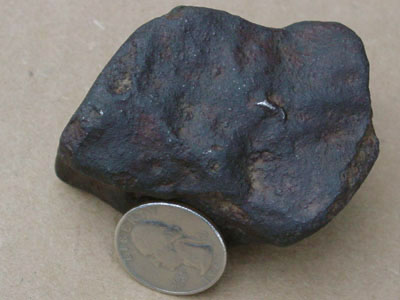
Another view of Forest
City (above),
showing that a small
ridge of metal
is protruding from
the fusion coating
(slightly to the right
of the center of
the image). There
are small indentations
or pits on the surface
of the meteorite.
|
|
Above is Allende
(CV3 carbonaceous chondrite). Patches of the fusion coating have
worn off, exposing the lighter gray
and speckled interior.
|
Below is the Gibeon
(IVA) iron meteorite,
showing well-developed
regmaglypts
(thumbprints) on the
surface of the meteorite.
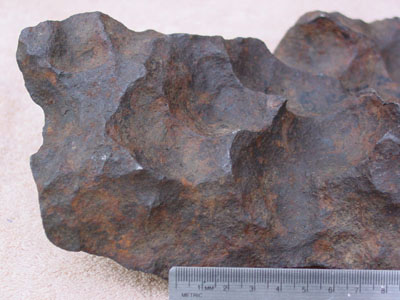
|
Below is the rust-colored
weathered fusion
coating on the Millbillillie
(eucrite
achondrite) meteorite.
Unweathered achondrites
tend to have especially
shiny fusion crusts.
|

Above is the interior
of the same sample of Millibillillie as at left. Notice again the
thinness of the fusion coating and the distinctly different interior.
|
SOLID AND COMPACT:
Most meteorites do not have the bubbly texture
(vesicular) that is often found in
many volcanic rocks on Earth. There are a few
exceptions to this rule.
DIFFERENT FROM THE OTHER
ROCKS IN THE AREA: Many meteorites
are composed entirely or in large part
of metal. These are obviously different
from the rocks found on the Earth's
surface. The stony meteorites are different
in appearance from most types of Earth
rocks, but unfortunately are similar in
appearance (at least with a fusion
crust) to the dark volanic rocks that are
common in Oregon and Washington.
Page last modified December 2, 2010

|

